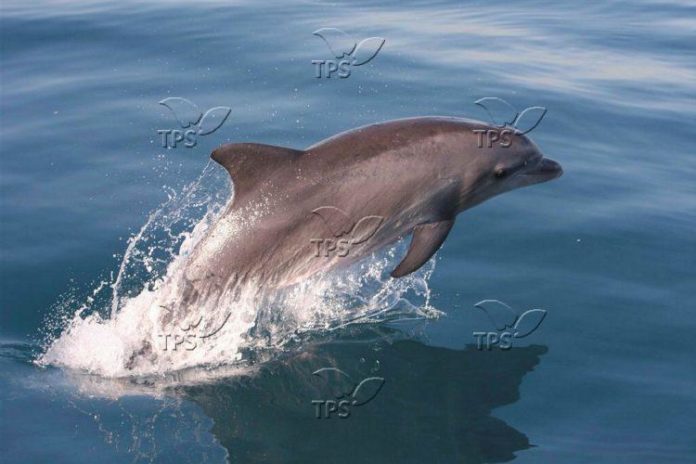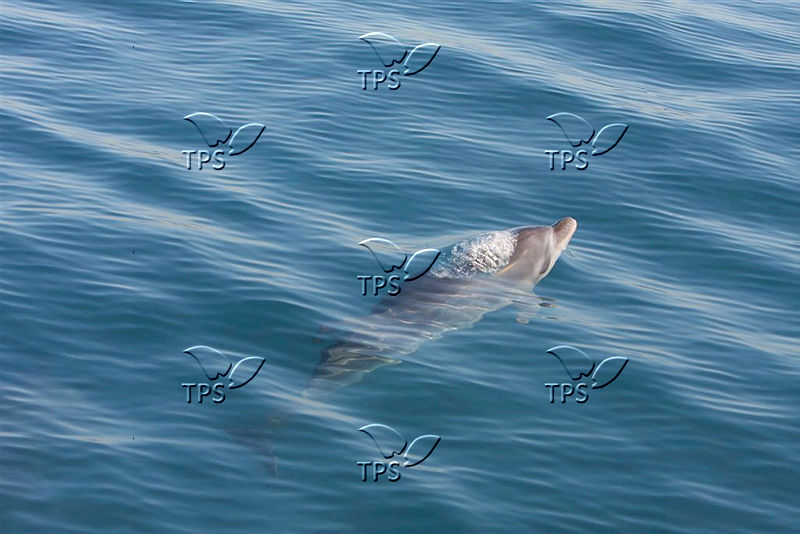On Israel’s Southern Coast, Endangered Dolphins Flourish
“Every encounter with a dolphin gives me a thrill” says Dr. Ruth Yahel, a marine ecologist at the Israel Nature and Parks Authority. “The sight of a dolphin darting out of the water and riding the bow wave, being joined by other dolphins and engaging in play together, is a spectacular scene which never gets boring. It epitomizes the wonder of creation before our very eyes.”
It is a sight that is not just wonderous and rare, it is also a sight that is considered somewhat of a surprise given the state of the dolphin population around the Mediterranean basin.
Two types of dolphins live along the Israeli shore, the common bottlenose dolphin and the common dolphin. Research on these species is relatively undeveloped, but evidence has emerged that a healthy colony of common dolphins is thriving near the Israeli shore, while in other parts of the Mediterranean Sea, they are gradually deteriorating and disappearing and are in fact in danger of extinction.
While bottlenose dolphins, which are considered a ‘vulnerable species’ in the Mediterranean, have been known to live along Israel’s coastline, the endangered common dolphins began to be sighted in 2005 on a strip some 70 kilometers long between Herzliya in the center of the country and Ashkelon in the south.
Despite the relatively limited space in which they have chosen to live, the colony seems to be thriving. Where did the colony originate, and why did they choose to live in this area?
“We don’t have a definitive answer” says Dr. Aviad Sheinin, director of the Israel Marine Mammal Research & Assistance Center (IMMRAC), an organization established by researchers from Haifa University, which has been researching dolphins in Israel since 1998. “The fact is, we began seeing the dolphins in the area right after IDF soldier Gilad Shalit was abducted and the Israeli authorities retaliated by restricting the Gaza fishing area. Our hunch”, he adds, “is that fishing kept the dolphins away from the Israeli coastline. In 2005, following restrictions placed on fishing on the Gaza coast, a marine corridor was exposed and the dolphins took their opportunity. Since then, it looks as though they are here to stay. Apparently they have enough sustenance here, since they are a strong colony, unlike others in different parts of the Mediterranean Sea.”
Over the years, IMMRAC researchers have published a series of studies about Israel’s dolphins, which eventually led the International Union for Conservation of Nature (IUCN) in 2017 to declare Israel’s seashores as important for both dolphin species. “IUCN is one of the leading international organizations for wildlife conservation, and this declaration is very significant”‘ says Sheinin, who has researched the dolphins in the area for so long that he can actually identify several of them individually. “It means that Israeli government must take the necessary measures in order to protect these rare mammals that have found refuge in our waters. “
The obvious step, Sheinin says, would be to create an ocean nature reserve in order to ensure the dolphins future. He added that Israel must also advance marine research along its coastline. “We have little knowledge of what’s going on in deeper waters surrounding our shores. We have yet to discover the implications of the gas drilling rigs, and there is still a lot to learn about the general situation of marine mammals living in Israeli economic waters. This research requires funding and extensive development,” notes Sheinin.
Much of Israel’s 196-kilometer-long Mediterranean coastline is taken up by port facilities, water desalination factories, military installations and more. Oil and gas rigs are the latest addition to waters already bustling with busy shipping lanes and fishing routes. “The very existence of dolphins in such crowded conditions is surprising”, says INPA marine ecologist Yahel. “For this reason we have, together with IMMRAC, formulated a proposal for a sizeable sea reserve along the southern coast – an area of approximately 75 square kilometers. It’s not a big reserve compared to land reserves in Israel, but we hope it will be enough to ensure the health and protection of the dolphin colony.”
The site of the proposed reserve is also one of the busiest fishing sites in Israel, attracting large numbers of trawlers and other fishing boats on a daily basis. “The dolphins have developed a tendency to hug the sides of the boats and grab fish from the nets, but by doing so they risk their lives” says Yahel. “Our goal is to facilitate safe and natural feeding which does not rely on human support, and the only way to do so is to stave off fishing activity”.
The ground-breaking marine reserve plan has been officially submitted, but there is still a long way to go before it gains the approval of Israel’s authorities. One of the main obstacles is the objections of the fishing industry, which says the project would harm its interests. But Yahel says that experience elsewhere in the world shows that “far from harming fishermen’s livelihood, marine reserves actually contribute to it by increasing the amount of fish in the sea.”
She says that “reserves enable colonies to build up in size and strength, as well as allowing rare species to recuperate and increase their numbers after having been nearly destroyed by intensive fishing. “
In fact, she continues, “in many cases, marine reserves were initiated in the interest of the fishing industry, rather than for the protection of wildlife. This is applicable to our case as well. The Israeli fishing industry will ultimately profit from the project, but the state needs the foresight to stand the first difficult years in order to harvest the gains later on.”
Ocean reserves can not only increase marine life and yield greater diversity, concludes Yahel, but can also lead to completely new phenomena. “Look what happened when the marine corridor opened around the Gaza Strip,” she says. “We can only try to imagine what other surprises nature has in store for us, if we only give it the opportunity to do so.”


 tos click here
tos click here



